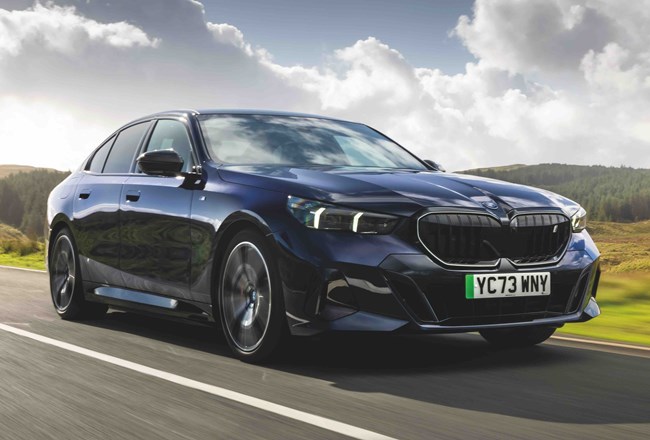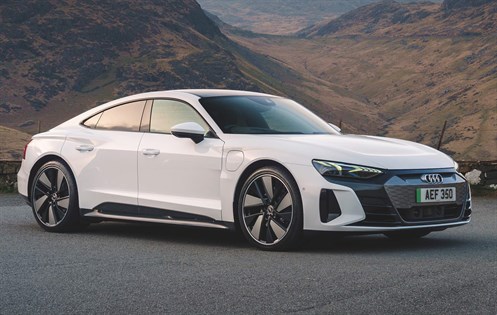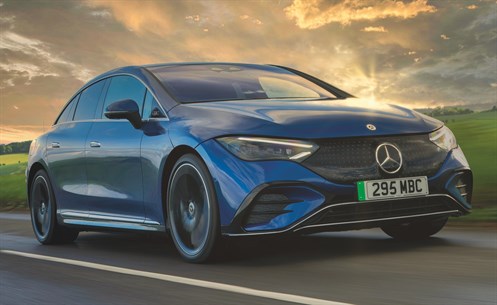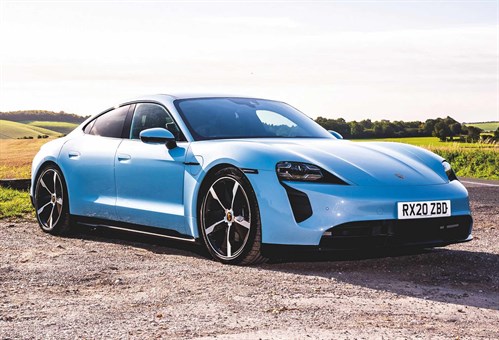We use cookies to ensure that we give you the best experience on our website. If you continue without changing your settings, we will assume that you are happy to receive all cookies on the Business Car website. However, if you would like to, you can change your cookies at any time

The start point for the best source of fleet information |
Best in Class: Executive EVs
Date: 22 December 2023 | Author: Martyn Collins

BMW i5
As a mark of how good the last-generation BMW 5 Series was, when it was about to go off sale, it was still ahead of the opposition in this year's Business Car Awards, and walked away with 'Best Executive Car,' again!
That seventh-generation car was petrol, diesel or hybrid-powered. It is a sign of the times and the growing acceptance of electric cars, that the focus of the latest G60 BMW 5 Series, is now the i5 electric version. Compared here in possibly most fleet-friendly, eDrive 40 M Sport spec. However, BMW hasn't totally forgotten the combustion engine in the 5, as there is a 205hp, 2.0-litre, four-cylinder petrol turbo-powered 520, with 48-volt mild hybrid technology available. Also inbound next year, are the 530e (299hp) and 550e (489hp) xDrive plug-in hybrids, with 56 and 62 miles of electric range respectively. However, the i5 is available in two distinctive flavours, the rear-drive eDrive 40, and the all-wheel drive M60 xDrive.
Outside, thankfully the 5's styling is toned down over the 7, and the result is attractive; sleek with sharp detailing. This 5 suits the thorough de-chrome that's standard on performance-orientated M Sport models, although the optionally lit LED kidney grille is a bit much in our opinion.
Rapid, grippy and fun sum up the drive - there's a 'Boost' paddle behind the steering wheel and when pulled like a gear shift, there's 10 seconds of peak acceleration. Apart from extra urgency when overtaking, it's largely irrelevant in everyday use. Sport mode is found in the 'My Modes' section of the drive modes, with names such as 'Expressive' and 'Relax.'
The steering is precise, but light, although there's enough feedback. Handling is tight, with plenty of grip in corners. Standard alloy wheel size is 19in, with the i5's extra weight equalling a slightly heavier feeling, with the suspension working hard to mask some road imperfections and keep the excellent body control.
Choose any one of this set and as they're all EVs, you'll be benefitting from the lowest BIK figure, at 2%.
We've said it before, but more than 200 miles of EV range is more than enough for everyday use. We're pleased to report that all of these EVs do that, and at least 50 miles more. The BMW at 354 miles, is however only good enough for second place in this group, with the Mercedes taking top spot.
The i5 might be the most affordable model of this set, but all are priced at over £70,000 - so you couldn't call any of them cheap. However, its 46% residual figure is the highest here, with the Porsche just behind. The Mercedes is in third place and the Audi in last. Other areas where the BMW in eDrive 40 form comes top, is that it has the lowest SMR figure at £3,101, with the Audi just behind in second place, and the Mercedes and Porsche bringing up the rear. This electric BMW has the lowest National Insurance figure, and at £204 it is a whole pound cheaper than the second-placed Mercedes. With wins in so many key areas, it's no surprise that the newest model in the set and the newest BMW comes top of the pile with its 77.64 cost per mile figure.
BMW i5 eDrive 40 M Sport
P11D: £74,050
CO2 (tax): 0g/km (2%)
BIK 20/40% a month: £24/£50
Range: 354 miles
National Insurance: £204
First year VED: £0
Subsequent VED: £0
Battery size/power: 84kWh/340hp
AFR: 9p
Residual value: 46%
Depreciation: £39,600
Fuel costs: £3,887
SMR: £3,101
Cost per mile: 77.64p
Audi E-Tron GT

The E-Tron GT might look like an Audi, but underneath it has more in common with the Porsche Taycan - another model in this set. With the usual pixel LED headlights, aggressive front air dam, large air ducts at the end of the front wheels to cool the brakes, blistered arches, and pop-up spoiler, this must be the best-looking Audi this side of the R8 supercar.
Inside, this Audi doesn't perhaps feel quite as special. This maybe down to the fact that the E-Tron GT shares its switchgear, steering wheel, and navigation system with lesser models. The interior still feels special and good quality.
Space in the rear of the E-Tron GT is perfectly acceptable for two children and average-sized adults - there's even a 405-litre boot that can be extended with the folding rear seats, although it has an awkward opening.
We think the lack of availability and the link with the Porsche Taycan has affected the Audi's showing here. Despite being the most expensive (P11D £86,795), the E-Tron GT is the highest depreciator at £52,510, over £7,500 worse than its sister model the Porsche! A great car, but the Audi finishes in last place here at 101p.
Audi E-Tron GT 93kWh
P11D: £86,795
CO2 (tax): 0g/km (2%)
BIK 20/40% a month: £28/£57
Range: 303 miles
National Insurance: £240
First year VED: £0
Subsequent VED: £0
Battery size/power: 93kWh/530hp
AFR: 9p
Residual value: 39%
Depreciation: £52,510
Fuel costs: £5,058
SMR: £3,232
Cost per mile: 101p
Mercedes-Benz EQE

The EQE might be smaller than the EQS, but this Mercedes shares its dedicated EV platform. Outside, it continues the cab-forward look first seen on its bigger brother, although seemingly scaled down. There's the same faired-in grille, front quarter lights, flush door handles and curvy rear light bar - you won't mistake it for any of the others here!
Inside, again you could be forgiven for thinking you're in the bigger EQS, as it certainly looks it. There's a 17.7in touchscreen, a tall centre console, and comfortable and supportive one-piece front seats. In the back, there's room for three passengers and a 430-litre boot.
As for the driving experience, the EQE is almost as conventional as an ICE-powered E-Class. We feel it was developed for comfort rather than dynamism, but the EQE still drives well, although you might wish for more involvement.
The EQE has the highest WLTP range of 376 miles, but that is the only area where this Mercedes stands out in this group. However, it is only just behind the i5, in terms of depreciation (£42,635), National Insurance (£205), residual value (42%), and P11D (£74,290), finishing in a solid second place here.
Mercedes EQE 300 84kWh AMG Line
P11D: £74,290
CO2 (tax): 0g/km (2%)
BIK 20/40% a month: £24/£49
Range: 376 miles
National Insurance: £205
First year VED: £0
Subsequent VED: £0
Battery size/power: 84kWh/245hp
AFR: 9p
Residual value: 42%
Depreciation: £42,635
Fuel costs: £3,884
SMR: £3,643
Cost per mile: 83.60p
Porsche Taycan

The Porsche Taycan shares the Audi E-Tron GT's J1 underpinnings, so how different could the Taycan be? It turns out to be quite different in fact.
Outside, while the Porsche and Audi share their front charging points, glass area, and overall dimensions, the Taycan very much has its own style, with oval headlights at the front, the side looking more like a stretched 911, rather than an electric Panamera. At the back, there's a 911-like light bar and a pop-up rear spoiler similar to the Audi.
Inside, the Taycan feels more special and more modern than the Audi, with a sculptural oval screen set on top of the dashboard, in front of the driver. Move to the back, and like the E-Tron GT, space in the rear is perfectly acceptable for two children, or average-sized adults.
Interestingly, there is less boot space in the Porsche than the Audi - 366 versus 405 litres. This can be extended by folding the rear seats. The boot has an awkward opening, like the Audi, making loading some items difficult.
The Porsche badge obviously holds kudos with premium EV buyers, and the Taycan with its £34,375 residual value depreciates the least. Elsewhere, the Taycan's figures are similar to the second-placed Mercedes, achieving a third-place cost-per-mile figure of 90.22p.
Porsche Taycan 79 kWh RWD
P11D: £79,200
CO2 (tax): 0g/km (2%)
BIK 20/40% a month: £26/£52
Range: 255 miles
National Insurance: £219
First year VED: £0
Subsequent VED: £0
Battery size/power: 79kWh/408hp
AFR: 9p
Residual value: 43%
Depreciation: £44,825
Fuel costs: £4,726
SMR: £4,583
Cost per mile: 90.22p











